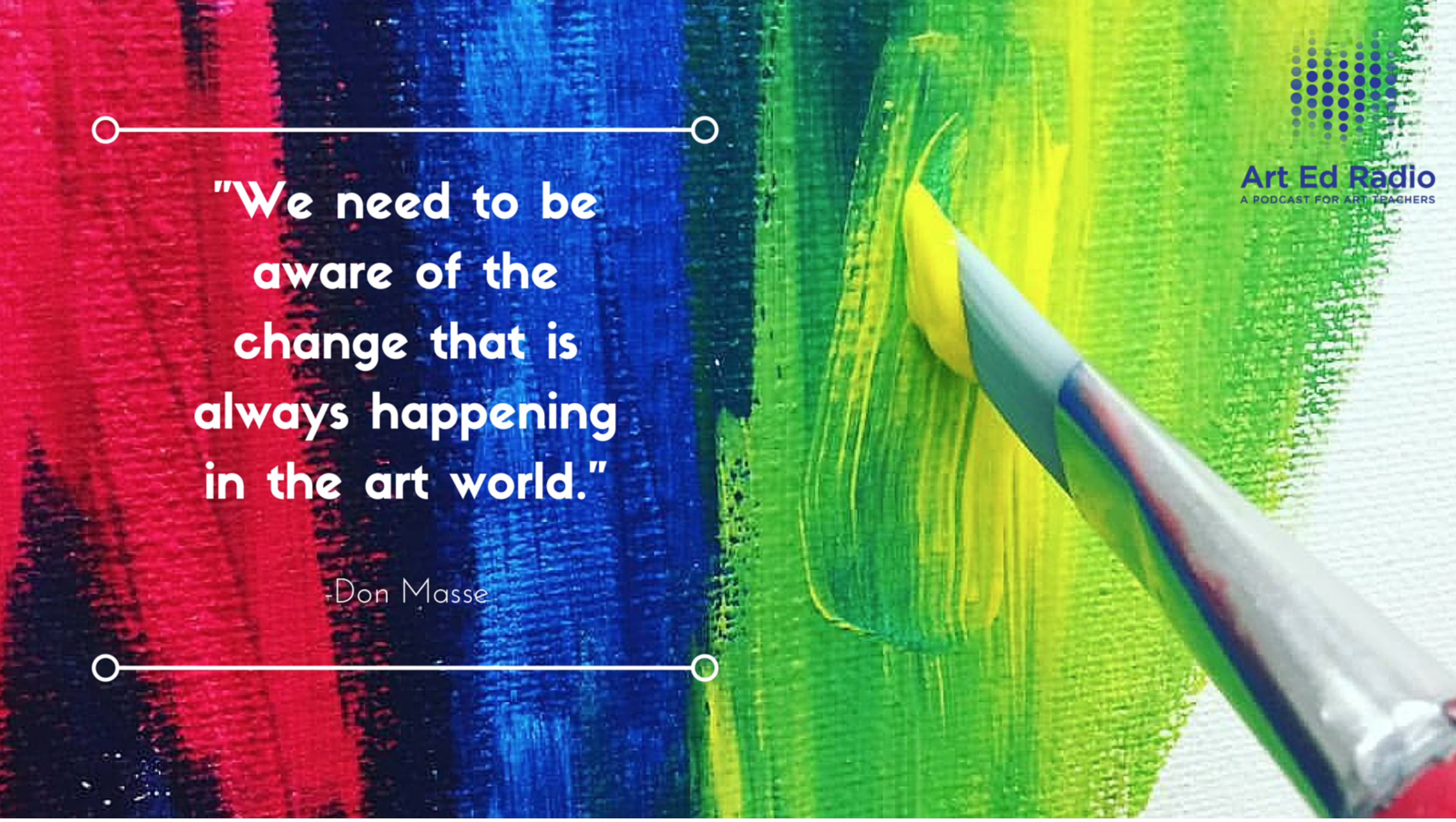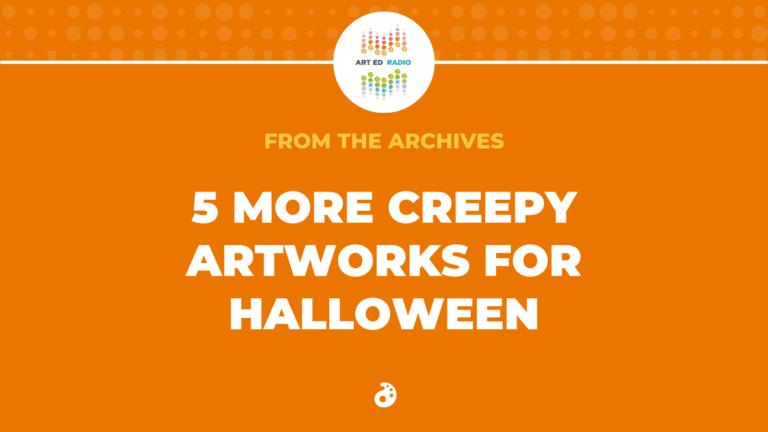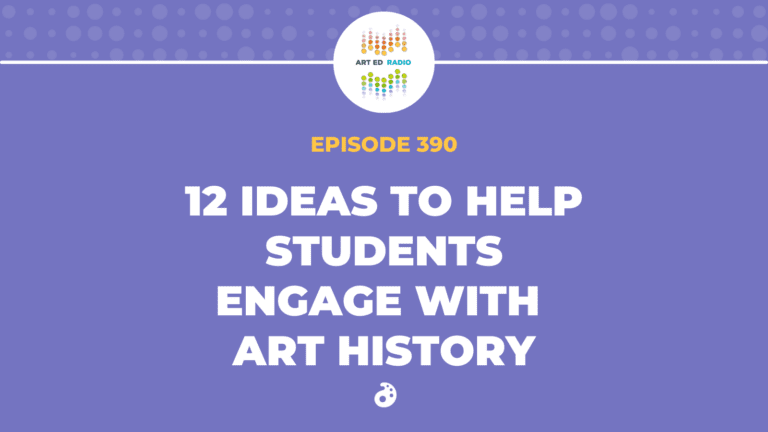Too often, art teachers rely on the canons of art history when introducing the subject to their students. This episode is here to tell you there’s a better way! Tim shares some of his best resources and reasons for teaching contemporary artists (listen for a cameo from the great Don Masse). Andrew comes on the show and he and Tim discuss their favorite contemporary artists (4:00), what art history looks like in their classrooms (8:30), and why we need to get away from those dead white guys (17:00). Tim closes the show by talking about the power of contemporary art to help develop thoughtful, inquisitive, and engaged students in your classroom. Full episode transcript below.
Resources and Links:
Resources and Links from AOE:
- The Top 10 Contemporary Artists to Teach Alongside Traditional Artists
- Where Does Black History Month Stand in the Art Room?
A great lesson from Don Masse:
The sites Tim mentioned to find great contemporary art resources:
- http://www.pbs.org/art21/
- http://www.thisiscolossal.com/
- http://www.booooooom.com/
- http://www.designboom.com/

Transcript:
Tim: Welcome to Art Ed Radio, the podcast for art teachers. This show is produced by The Art Of Education and I’m your host, Tim Bogatz. The world of contemporary art is vast. It can be difficult to understand and difficult to navigate.
In this episode, No More Dead White Guys, we’re going to talk about how to dive into the world of contemporary art or at least dip your toes in to move beyond the stale curriculum of European masters that make up far too much of what art teachers often share with their students. My favorite co-host, Andrew McCormick, will join me in just a little while as we discuss art history, its role in our classrooms, and all of the ways we can move past the traditional canons of art history.
The biggest names in art history come to mind in a flash. Da Vinci, Rembrandt, Van Gogh, Monet, Picasso, they’re wonderful, each and every one of them. I teach about all of those artists because they have so much to tell about art and its history. I would argue though that we need to move beyond those names fairly quickly because there’s so many more artists out there. Those artists have so much more to offer, but what exactly do contemporary artists have to offer? I’m glad you asked.
Don: They can serve as a bridge, a connection between the historical content and the work being done now in today’s society.
Tim: That’s Don Massey, an elementary art teacher from San Diego, California. He gave an incredible talk during the AOE Winter Conference about the benefits of using contemporary artists in your classroom including making connections and making the art you teach more relevant to the kids in your classroom.
However, it has to be more than just a two minute introduction or fly by night overview of what those artists are doing. A quick showing of some cool artwork isn’t enough. As teachers, we really need to think about what goes beyond that. You need to make sure that the lesson is engaging, the project, and everything so it’s not just like a trick at the beginning and then you go right back into your regular routine.
You need to think about just the integrity of the lesson. Make sure it still has value and excitement that’s going to carry the kids through. It’s not that difficult honestly. There’s so many resources out there for teaching art history. Art 21 from PBS is a great places to start. You can check sites like Boom, This Is Colossal, and DesignBoom.com. The Art Of Ed has a plethora of articles.
Just reading blogs from some of your favorite art teachers will give you so many ideas of what you can do to incorporate contemporary artists in your classroom. Now once you have these resources and have those artists in mind, you’ll begin to see the benefits that come with teaching contemporary art. Your kids are engaged. Your kids are excited. Your kids are curious. They’re asking better questions.
They’re thinking about the world around them. They’re seeing how art is influencing and being influenced by popular culture, the media, and other subjects that are of interest to them. More importantly, they have a gateway that’s developing that leads them into the bigger world of art history. Now to talk about all of these ideas and a whole lot more, let’s welcome on Mr. Andrew McCormick. I am here now with Andrew McCormick. Andrew, how are you?
Andrew: Hey, I’m good man. How are you doing?
Tim: Very well. I’ve been talking today about all the benefits to teaching about artists outside the traditional canons of art history, outside of those dead white guys. We’ll circle back around to all the benefits in just a second. First, let me ask you this. Who are some of your favorite artists to teach in your classroom?
Andrew: I’ll probably end up, I’m going to circle back first because I think some of the first ones I’ll come up with are probably dead white guys. I feel like I definitely gravitate a lot towards pop art with a lot of mine.
I definitely feel like my students end up leaving my classroom with a heavy dose of Andy Warhol, Lichtenstein, even Robert Rauschenberg, who I know is couched in with pop artists, but is maybe more or in different time periods as well. There’s another artist I feel that comes up a lot in my classroom, Hannah Hoch. I think I’m saying that right. Although, I’ve heard Hoch, Hakkah, Hawk.
Tim: I’ve always just, yeah, yeah. I like her. My kids don’t like her as much, but I do. I’ve always just said Hannah Hoch. I don’t know. I guess if you want to get excessively German, then you can.
Andrew: People who are much smarter than me, I’ve heard them say, “Hakkah.” I was like, “I’ll fall for that.” Then, I also really like this guy named Philip Guston. For years, I walked around thinking that he was some French guy and I called him Philip Guston. I was like, “Uh, you mean old Phil Guston from Missouri, Phil Guston? Yeah, I’m an idiot.”
Tim: That’s the guy.
Andrew: Then, my all time favorite artist, and I once had a kid ask me. A very deep, reflective student once out of the blue just asked me, “Mr. McCormick, when did you know that you wanted to be an artist?” I was like, “Whoa, that’s a heavy question.” I thought back to when I was in ninth grade actually in Omaha, Nebraska, your neck of the woods.
I went and saw a retrospective of Jean Michel Basquiat and it was a transformative moment for me. Jean Michel Basquiat is probably my all time favorite artist. I don’t know that I teach him deliberately, but I show him often to my students as one of my heroes.
Tim: That’s awesome. That connection is good too because kids always want to know what you’re interested in. That comes through in different ways. If you can go in and just say, “Guys, I really want to pay attention, you know. I want you to check this out because this is my all time favorite artist,” that really captures that attention. That’s a good anticipatory set right there.
Andrew: Robert Rauschenberg is up there for me too. I just really like his sensibilities. It’s like Jean Michel and then Robert Rauschenberg number two.
Tim: That’s cool. Mine is probably Maya Lin. I love just her minimalist sense of style and the monument she’s done and her architecture, all that stuff. That is a great way that I introduce her too. I just say, “You guys, check this out.” I think the Vietnam Memorial is one of the great all time artworks. She’s one of my all time favorite artists. That really does capture kid’s attention.
Then, the other thing, the other two artists that I just thought of off the top of my head that really my kids get into, Cai Guo-Qiang, a Chinese artist who does all of the fireworks, explosions, and all that stuff. Kids love seeing that. Kehinde Wiley is a big one too that my kids just absolutely love.
Andrew: He’s a great one. I’ve used him before. There’s so much that you can talk about with notions of identity and deeper meaning. It’s also kids love it because it’s relevant, current, and masterfully done. It just looks amazing and beautiful while also bringing up some deeper issues.
Tim: I think that actually his work fits into what I wanted to ask you next actually. A question is do you ever find that the artists that you show your kids actually take you back to some of those “dead white guys?” Wiley’s work references so many different works from art history.
That works out well for me because it serves as a springboard into some bigger discussions and introducing some other artists from art history. Let’s put it this way. Can the artists that you love or that you show to your kids, can they serve as a gateway to the larger world of art history?
Andrew: For sure and I think it’s important to show kids like, “Listen, this person didn’t just show up.” Let’s say a contemporary artist. They don’t just show up out of a vacuum and start making work, especially work that’s edgy and meaningful and relevant. That artist is going to be looking at their exemplars and their history and being critical of it and maybe imitating it and winking at it and flirting at it. It definitely can work that way.
I got to say though just from the year that we’ve spent getting to know each other, you do a really great job of really bringing in a lot of art history. As a middle school teacher with slightly younger students, my art history is a little faster, a little quicker. I notice I can lose kids pretty quick if I have a really dry anticipatory set of like, “Now we’re going to talk about art history.” I can just feel the life sucking out of the room. I try to keep it snappy, keep it moving.
When I do reference back to historical examples we try to do it fairly quickly. Now I feel like I grew up out of the DBEA approach, discipline-based art ed, where you always had to have that art history. As I’ve evolved a little bit more past that, what I try to do is I try to show what I would maybe consider to be a blue chip famous artist that even people who don’t like art have heard of, Monet, Picasso, Van Gogh, someone of that stature.
Then, I very, very quickly move on to, “And here’s someone that’s making artwork right now.” That’s the thing that’s most important. You call the show No More Dead White Guys. To me, of those adjectives, the one that’s the most important is dead. We need to show our students that art is not just something that happened a long, long time ago and is now nice and neat and sanctified in a museum. It’s going on right now by people who are not much older than you are. I quickly do some old historical stuff and then I move on to people who are making artwork right now. That’s super important.
Tim: I do too. Contemporary connection is something that really draws kids in. If we just go back to Cai Guo-Qiang, talking about good anticipatory sets like, “Let’s watch a YouTube video of these fireworks that create a ladder that literally goes a mile up into the sky.” That blows their mind a little bit. Then, you’ve got them. At the same time, you can talk about how he did the opening ceremonies for the 2008 Olympics in Beijing.
All of a sudden, all of these connections of what’s going on right here really, really come to life for kids. I want to dig in a little bit deeper here just talking about art history, where it fits within your lessons. What does specifically it look like in your classroom? Is it planned with lessons or with certain projects? Do you just share stuff with kids as it comes up in discussion? Do you ever just do art history for art history’s sake? What works for you?
Andrew: What definitely doesn’t work for me was the last one you said, which was art history for art history’s sake. That’s a surefire way to have kids really check out and snooze on you. I remember, as a high school student, that’s what we did. “Studio, studio, studio, and guess what? As a treat, guys, the last two weeks of the semester, you don’t get to make any artwork and you get to watch two weeks worth of videos about art history.”
Tim: That’s terrible.
Andrew: It’s terrible because it’s not connected to anything you’re doing because you’re done making artwork now. I definitely don’t do that. That’s a really bad idea for me. I try with every project to have a little show at the beginning, a little PowerPoint, and, “Here’s some people we’re going to look at.” One of the things that I’ve actually done, and my talk at NAEA actually was about this concept of letting your students steer some of this stuff.
I’ll show my students a much shorter version of my examples and models and people that I think relate to it. I realized a couple years ago one of the things I’m really good at in art teaching and that I enjoy is making these really grand presentations. Like, “Oh man, I’m going to show them all these connections and all these artists and they’re going to love it,” and it’s 70 slides long. No kid wants to watch a 70 point slideshow, despite how witty and relevant and great connections you think you’re making.
Now 15 or under is my rule of thumb. What I do a lot lately is I actually then want my students to show me what they think is cool in a given theme or topic or idea. I want to know what they’re looking at. That’s one of my big beefs with dead white European guys from a long time ago. A lot of kids don’t see that artwork as having some relevance or resonating with what their life is like right now.
When they look at what’s out there right now, maybe it’s not even a “fine” artist. Maybe it’s even some visual culture stuff, character designers at a video game company or costume or set designers for Hollywood. Those are things that might be more resonating with students that they want to show me as what they think is cool.
I’ve really enjoyed loosening it up. Now, anyone who has listened to this podcast knows that we’re both big fans of not either or, but having it both ways. I still want to show my kids that historical background and underpinning to things, but then yet also let them show me some cool stuff that’s a little more out there, a little more current, a little more relevant.
Tim: That’s a really good way to do things. I’m going to share with you something that I do just to give an example of what I do with art history and just get your thoughts, if that’s cool. One thing that I do in my classroom, it relates to art history and it’s a lot of contemporary art. It’s called social issue silhouettes and just came up with this a couple years ago. We look at and talk about the work of Kara Walker for a couple days. I don’t know if you’re familiar with her.
Andrew: Yep.
Tim: Her work is dark and there are some really difficult issues that it brings up. It’s also really engaging for my kids. We have really, really meaningful discussions. We’ll spend a day talking about social issues or current events or just anything else that’s affecting our kid’s lives. Then, after that, they’re going to create their own silhouettes that address some of these issues. I like that because working in silhouettes is a new drawing challenge.
It forces them to think a little bit differently when you can’t have detail. Depth is done a little bit differently. You just have to have a lot of clarity in your images. I love that project. I love having the contemporary artists serve as the catalyst for all of that. It provides some engagement, some curiosity, and some questioning that I don’t necessarily always see from my kids. What are your thoughts on doing things like that?
Andrew: I think that’s fantastic. This is the thing I’ve been grappling a lot with with just other teachers or in thinking about my own practice. All people, whether we think of artists or students or young artists, want to make work that is meaningful. They want to create meaning through artwork. Showing students an artist that might be a little edgy or controversial is really fantastic and great. It’s a great way to get them going.
Sometimes we, as teachers, the school districts that we work in, everyone works in, sometimes we’re a little cowed to be safe and sanitized. We think, “Well, this talks about identity or it talks about race or it talks about discrimination or stereotypes. That’s kind of a heavy topic.” Your kids can handle it. Trust me. They’re talking and dealing with these things out there. Why not make those issues be applicable and something that they can work with in the art room? It’s a win-win.
Tim: I would agree. That covers a lot of what I wanted to get to with you. If we can just wrap this all up in, I don’t know, one nice, little package here, we’ve talked about levels of engagement and dealing with meaningful issues and all that. If you can just wrap it up in a sentence or two, what to you are the biggest benefits with teaching contemporary artists or teaching the artists that you love?
Andrew: I’m already rambling. See, I’m prefacing. One word? It’s relevance, letting students look at contemporary artwork, artwork made by people who look and have a background like they do. If you have minority students, female students, it’s really important that they see in the art world heroes of theirs that look and have a world like theirs. If all we do is bring in the blue chip, art history book, dead white European guys, we’re leaving so much off the table. We’re missing so many opportunities to show students that art is a vibrant and amazing world and anyone and everyone gets into it.
Tim: Exactly. That is a beautiful way to wrap that up. We’re going to close up shop right there.
Andrew: It wasn’t very short though. You should know me well enough by now. If you say, “Make it short,” it’s going to ramble on a little bit.
Tim: Very true. We still appreciate it though. It’s still very well-said. Thank you very much, Andrew. It’s been good talking to you.
Andrew: Thanks for having me on, Tim. We’ll see you later.
Tim: Now, if this discussion between Andrew and I captured your attention, Integrating Art History is the class for you. If you’re in need of grad credits or PD hours and you want to learn about how to revamp your curriculum to bring in more art history, how to get more out of the art history you already do, and learn a plethora of new ideas, Integrating Art History is the place to be.
The class is worth two credits, runs four weeks, and as with all of our classes it starts on the first of each month. You can learn more by going to TheArtOfEd.com and clicking on the courses tab. Now, as we close the show, I want to bring Don Massey on one last time.
Don: We need to keep ourselves, as teachers, engaged and sharp. We need to think about not only what has happened in the past, but we need to have a strong clue as to what’s going on in today’s society too. We need to be advocates and aware of change that’s happening in the art world. This is what the kids are interested in. We need to make sure that we stay up on that so that really we are lifelong learners of change and that change is caused by artists and critical and creative thinkers.
Tim: Don says it all right there. It’s about us reacting to and learning from the world around us and the art that’s being made within it. It’s not that we can’t or shouldn’t teach those masters that I mentioned. Van Gogh, Rembrandt, Picasso, da Vinci, and Monet are all valuable parts of art history. They have a place in every classroom, but there is so much more out there. Find those resources. Discover those artists. Share them with your students.
You’ll have kids that are more engaged, more curious, asking better questions, and thinking more about the world in which they live. When you bring in relevant, contemporary, thought-provoking artists and resources you’ll have, if I can put it simply, a classroom that encourages active learning and growth. To ignore these artists that can do so much for your students is to do your students a disservice. Don’t just teach the dead white guys. You can do better than that. You can be better than that.
Art Ed Radio is developed, produced, and supported by The Art Of Education with audio engineering by Michael Crocker. We appreciate all of you that have subscribed to the show and we appreciate all the comments we’ve received on iTunes because we’re always looking to get better. Hit up TheArtOfEd.com and click on the podcast link where you can find this and every episode, including a ton of resources, that can come back to your classroom immediately. New episodes are released every Tuesday. Look for us then.
Magazine articles and podcasts are opinions of professional education contributors and do not necessarily represent the position of the Art of Education University (AOEU) or its academic offerings. Contributors use terms in the way they are most often talked about in the scope of their educational experiences.



